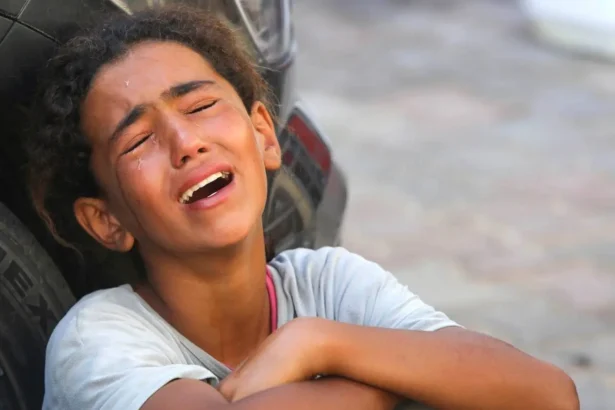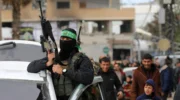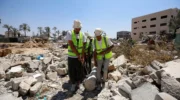One of the main victims of the ongoing assault on Gaza has been a group that is, by far, the most defenseless and further removed from all that is driving Israel’s campaign of death and destruction: children.
Two articles below:
by Anadolu Agency, reposted from Middle East Monitor, July 11, 2024
Philippe Lazzarini, head of the UN Relief and Works Agency for Palestine Refugees (UNRWA), aptly described the Israeli offensive as “a war on children … a war on their childhood and their future.”
His stark warning was echoed by UN chief, Antonio Guterres, who said in a General Assembly speech in May: “If there is a hell on earth, it is the lives of children in Gaza.”
These statements are grounded in facts and heartbreaking figures, with tens of thousands of child casualties already documented in Israel’s deadly war.
As of April 2024, there were over 1.06 million – 1,067,986 – children in the Gaza Strip, making up approximately 47 per cent of its total population, according to the Palestinian Central Bureau of Statistics.
There were an estimated 544,776 males and 523,210 females under the age of 18, with approximately 15 per cent of them being under the age of five, equivalent to 341,790 minors, the Bureau’s data showed.
Nearly 16,000 children killed:
Back in March, Lazzarini shared figures showing that the number of children Israel had killed in Gaza in just over four months was higher than the total number of children killed around the entire world in four years.
At the time, the death toll of children in Gaza stood at over 12,300, exceeding the number of 12,193 killed in global wars between 2019 and 2022, according to UN figures.
A few months ago in December, a World Health Organization official said an average of one Palestinian child was killed every 10 minutes in Gaza, describing the crisis as “humanity’s darkest hour”.
Children in Gaza have suffered the highest toll in this crisis.
The harrowing statistics have since grown bleaker as Israel continues bombing anything and everything, from hospitals to residential buildings and camps sheltering millions of displaced Palestinians.
As of July 7, which was the 275th day of Israel’s war, its forces had killed at least 15,983 Palestinian children in Gaza – an average of 58 every single day since October 7 last year.
The number of children injured is also above 34,000, according to figures from Gaza’s Health Ministry.
Children in Gaza have suffered the highest toll in this crisis. We are seeing children killed and maimed in unprecedented numbers. Children are being killed in the most horrific ways possible. Alexandra Saieh, head of humanitarian policy and advocacy at Save the Children International, told Anadolu
“They are being dismembered. They have been burned alive in tents. They have been killed due to collapsing apartment building blocks. They have also been killed by preventable diseases and illnesses and denied medical assistance. Children in Gaza are just suffering horrifically.”
1,500 children lost limbs or suffered from other disabilities:
At least 1,500 children in Gaza have lost their limbs or eyes, or suffered from other permanent disabilities due to Israeli attacks, according to figures from the Gaza government media office.
In January, UNICEF reported that more than 1,000 Palestinian children had one or both legs amputated since October 7.
That meant more than 10 children losing one or both of their legs every single day.
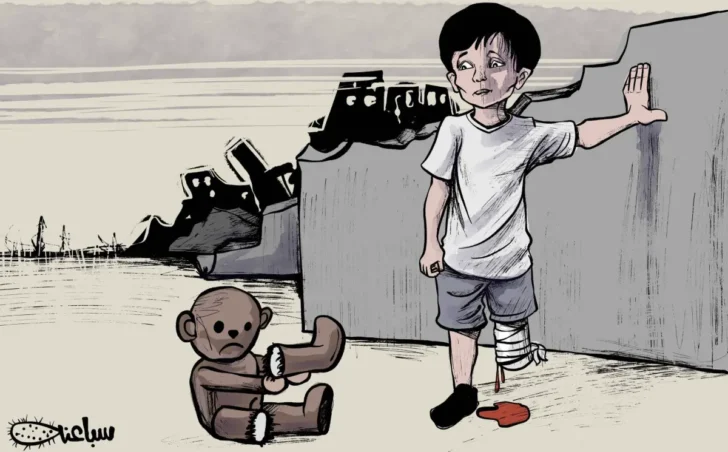
As Israel has also destroyed Gaza’s medical infrastructure and imposed a crippling blockade on humanitarian supplies, several UN agencies and rights groups have reported that children are going through amputations and operations without any anesthetic.
Many distressing videos of these procedures have also come out on social media, showing the world the immense suffering of Gaza’s children.
In many cases, as pointed out by Francesca Albanese, a UN Special Rapporteur, children in Gaza are only given sedatives to ease their pain as the treatment they require is simply not available.
“This level of horror is unmatched in our lifetime,” she said in a post on X.
Saieh also spoke about the gruesome ways Gazan children have been maimed by Israeli attacks, suffering “life-altering injuries”.
“A child without a leg cannot flee to the so-called safe zone. A child who is so starved that he or she is too weak to cry, can no longer flee,” she said.
21,000 children missing, 17,000 orphaned:
Save the Children recently reported that up to 21,000 Palestinian children are missing in Gaza, with many trapped beneath rubble, detained by Israeli forces or buried in unmarked graves.
Many more children “are lost, separated from their family members, their loved ones,” Saieh told Anadolu.
“Around 4,000 are presumed to be dead, buried under the rubble of their own homes, and then an unknown number are buried in unmarked graves, and detained or disappeared by Israeli forces in unknown locations,” she said.
According to Gaza’s government media office, at least 3,600 children are missing under the rubble of thousands of buildings destroyed in Israeli attacks.
As of June 14, the office said at least 200 children had been “kidnapped” by Israeli forces.
As Israel rains down death and destruction on Gaza, organisations like Doctors Without Borders have even coined a new term to identify children without surviving family members: WCNSF – wounded child, no surviving family.
The Gaza media office has identified around 17,000 Palestinian children who have been orphaned, with at least 3 per cent – 510 – having lost both parents.
Malnutrition: Dozens killed, tens of thousands more at risk:
Israel, which is facing a genocide case at the International Court of Justice, has also been accused by legal experts of using starvation as a weapon of war.
According to Gaza’s Health Ministry and a group of UN-backed independent experts, at least 34 people, most of them children, have died of malnutrition in Gaza since last October.
“With the death of these children from starvation … there is no doubt that famine has spread from northern Gaza into central and southern Gaza,” the UN-backed experts said in a statement on July 9.
We declare that Israel’s intentional and targeted starvation campaign against the Palestinian people is a form of genocidal violence and has resulted in famine across all of Gaza
Human Rights Watch has also confirmed that children in Gaza are succumbing to “starvation-related complications” as Israel continues to use starvation as a “weapon of war”.
UNRWA warned that more than 50,000 children need urgent treatment for acute malnutrition, while the Gaza media office has said that at least 3,500 children are at risk of death due to malnutrition and food shortages.
Additionally, the government media office said at least 82,000 children have shown signs of malnutrition, with 35 per cent of them having severe symptoms.
Another 450,000 children are at risk of developing chest cancer and respiratory diseases as Palestinians are forced to burn various hazardous materials to cook food, it added.
Over 700,000 children displaced:
According to UN figures, up to 1.9 million people are internally displaced in Gaza, many of them forced to move nine or 10 times.
This includes more than 700,000 children who have also been forcibly displaced multiple times, figures from the Gaza government media office show.
Approximately 650,000 children have lost their homes that were destroyed in Israeli attacks, the office said, while at least 625,000 have been out of school for over 10 months now.
Save the Children’s Saieh emphasized that any and all infrastructure is essential for children to thrive in the future has been destroyed in Gaza.
“Schools have been destroyed, hospitals have been destroyed, playgrounds have been destroyed, homes have been destroyed,” she said.
“Children in Gaza tell us that they have no hope for the future.”
Anadolu Agency is a state-run news agency headquartered in Ankara, Turkey.
Israeli weapons packed with shrapnel causing devastating injuries to children in Gaza, doctors say
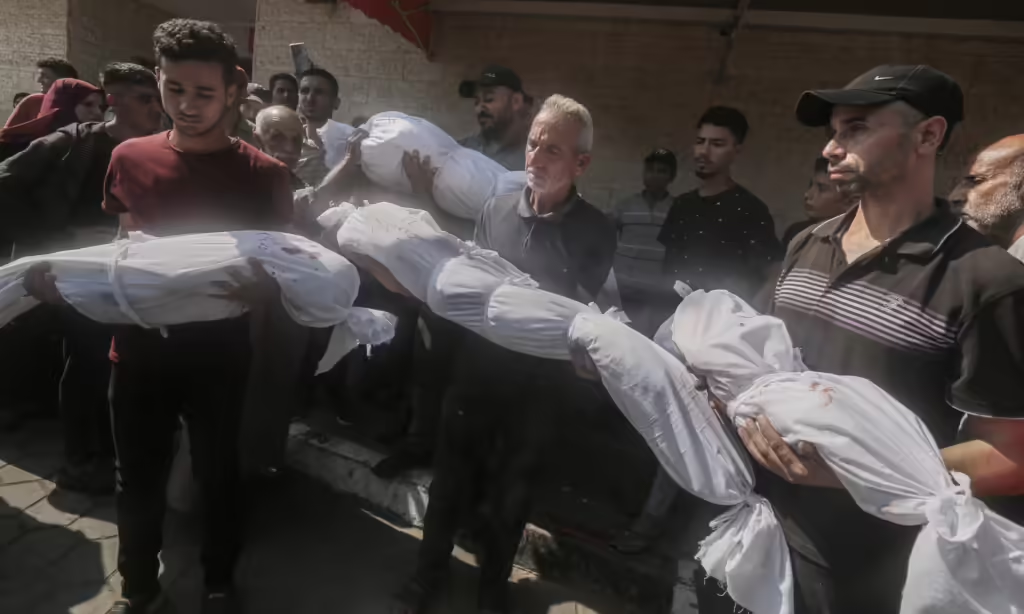
Surgeons who worked in European and al-Aqsa hospitals describe extensive wounds caused by ‘fragmentation’ shrapnel experts say is designed to maximize casualties…
by Chris McGreal, reposted from The Guardian, July 11, 2024
Israeli-made weapons designed to spray high levels of shrapnel are causing horrific injuries to civilians in Gaza and disproportionately harming children, foreign surgeons who worked in the territory in recent months have told The Guardian.
The doctors say many of the deaths, amputations and life changing wounds to children they have treated came from the firing of missiles and shells – in areas crowded with civilians – packed with additional metal designed to fragment into tiny pieces of shrapnel.
Volunteer doctors at two Gaza hospitals said that a majority of their operations were on children hit by small pieces of shrapnel that leave barely discernible entry wounds but create extensive destruction inside the body. Amnesty International has said that the weapons appear designed to maximize casualties.
Feroze Sidhwa, a trauma surgeon from California, worked at the European hospital in southern Gaza in April.
“About half of the injuries I took care of were in young kids. We saw a lot of so-called splinter injuries that were very, very small to the point that you easily missed them while examining a patient. Much, much smaller than anything I’ve seen before but they caused tremendous damage on the inside,” he said.
Weapons experts said the shrapnel and wounds are consistent with Israeli-made weapons designed to create large numbers of casualties unlike more conventional weapons used to destroy buildings. The experts question why they are being fired into areas packed with civilians.
The Guardian spoke to six foreign doctors who have worked at two hospitals in Gaza, the European and al-Aqsa, in the last three months. All of them described encountering extensive wounds caused by “fragmentation” weapons, which they said have contributed to alarming rates of amputations since the war began. They said the injuries were seen in adults and children but that the damage done was likely to be more severe to younger bodies.
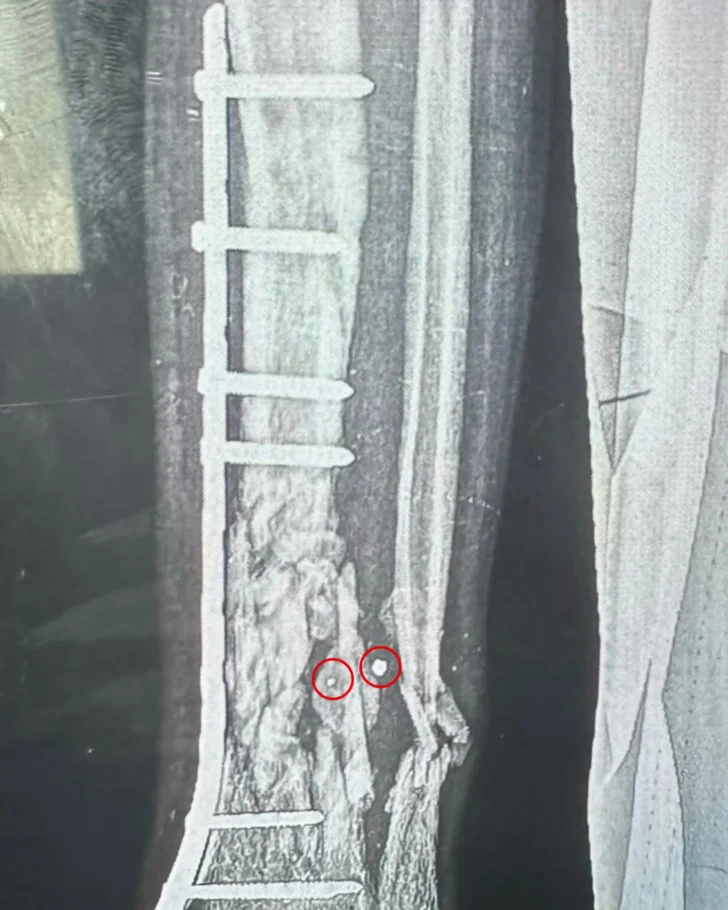
“Children are more vulnerable to any penetrating injury because they have smaller bodies. Their vital parts are smaller and easier to disrupt. When children have lacerated blood vessels, their blood vessels are already so small it’s very hard to put them back together. The artery that feeds the leg, the femoral artery, is only the thickness of a noodle in a small child. It’s very, very small. So repairing it and keeping the kid’s limb attached to them is very difficult,” Sidhwa said.
Mark Perlmutter, an orthopedic surgeon from North Carolina, worked at the same hospital as Sidhwa.
“By far the most common wounds are one or two millimeter entry and exit wounds,” he said.
“X-rays showed demolished bones with a pinhole wound on one side, a pinhole on the other, and a bone that looks like a tractor trailer drove over it. The children we operated on, most of them had these small entrance and exit points.”
Perlmutter said children hit by multiple pieces of tiny shards often died and many of those who survived lost limbs.
“Most of the kids that survived had neurologic injuries and vascular injuries, a major cause of amputation. The blood vessels or the nerves get hit, and they come in a day later and the leg is dead or the arm is dead,” he said.
Sanjay Adusumilli, an Australian surgeon who worked at the al-Aqsa hospital in central Gaza in April, recovered shrapnel made up of small metal cubes about three millimeters wide while operating on a young boy. He described wounds from fragmentation weapons distinguished by the shards of shrapnel destroying bone and organs while leaving just a scratch on the skin.
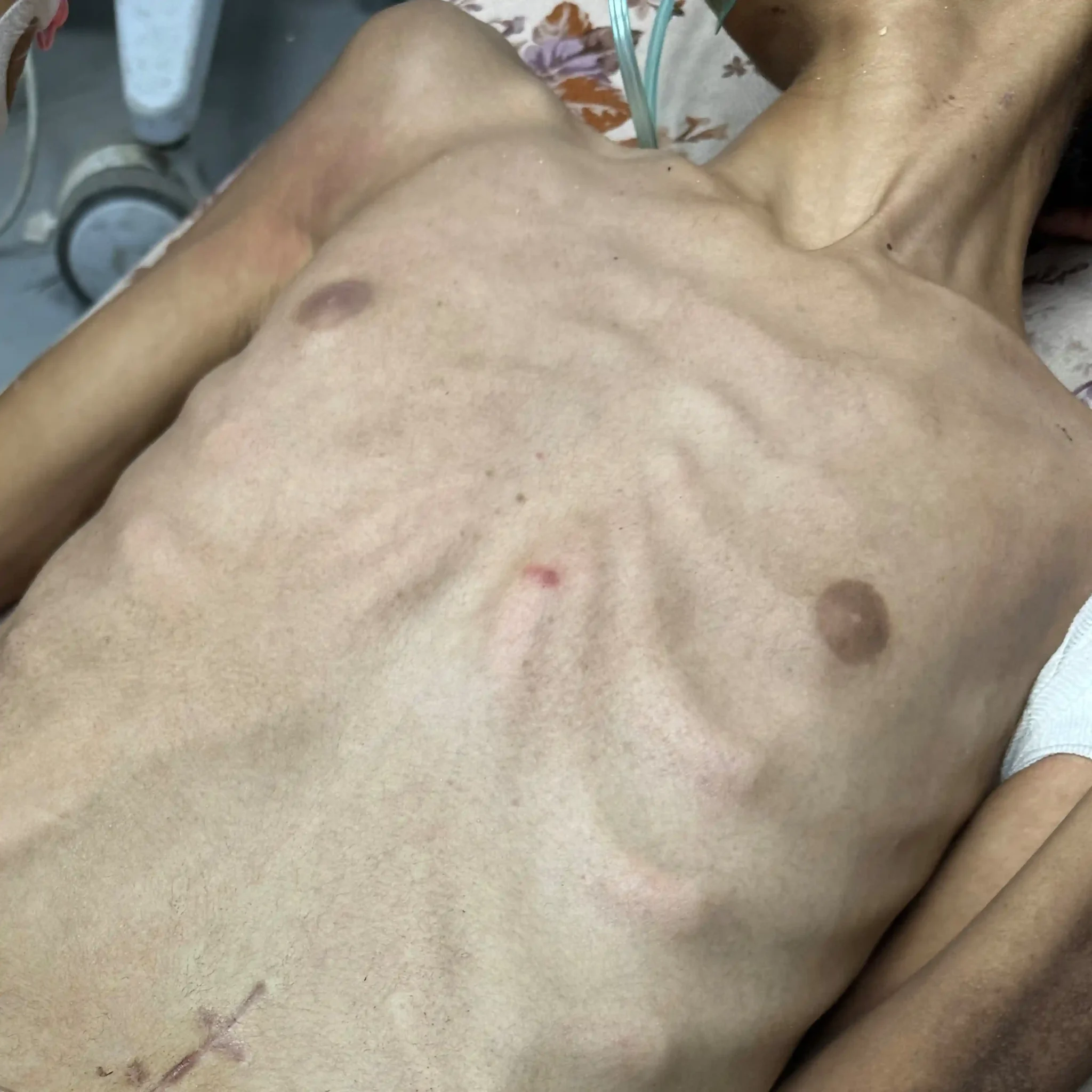
Explosives experts who reviewed pictures of the shrapnel and the doctors’ descriptions of the wounds said they were consistent with bombs and shells fitted with a “fragmentation sleeve” around the explosive warhead in order to maximize casualties. Their use has also been documented in past Israeli offensives in Gaza.
Trevor Ball, a former US army explosive ordnance disposal technician, said the explosive sprays out tungsten cubes and ball bearings that are far more lethal than the blast itself.
“These balls and cubes are the main fragmentation effect from these munitions, with the munition casing providing a much smaller portion of the fragmentation effect. Most traditional artillery rounds and bombs rely on the munition casing itself rather than added fragmentation liners,” he said.
Ball said the metal cubes recovered by Adusumilli are typically found in Israeli-made weapons such as certain types of Spike missiles fired from drones. He said the doctors’ accounts of tiny entry wounds are also consistent with glide bombs and tank rounds fitted with fragmentation sleeves such as the M329 APAM shell, which is designed to penetrate buildings, and the M339 round which its manufacturer, Elbit Systems of Haifa, describes as “highly lethal against dismounted infantry”.
Some of the weapons are designed to penetrate buildings and kill everyone within the walls. But when they are dropped onto streets or among tents, there is no such containment.
“The issue comes with how these small munitions are being employed,” said Ball. “Even a relatively small munition employed in a crowded space, especially a space with little to no protection against fragmentation, such as a refugee camp with tents, can lead to significant deaths and injuries.”
Amnesty International first identified ammunition packed with the metal cubes used in Spike missiles in Gaza in 2009.
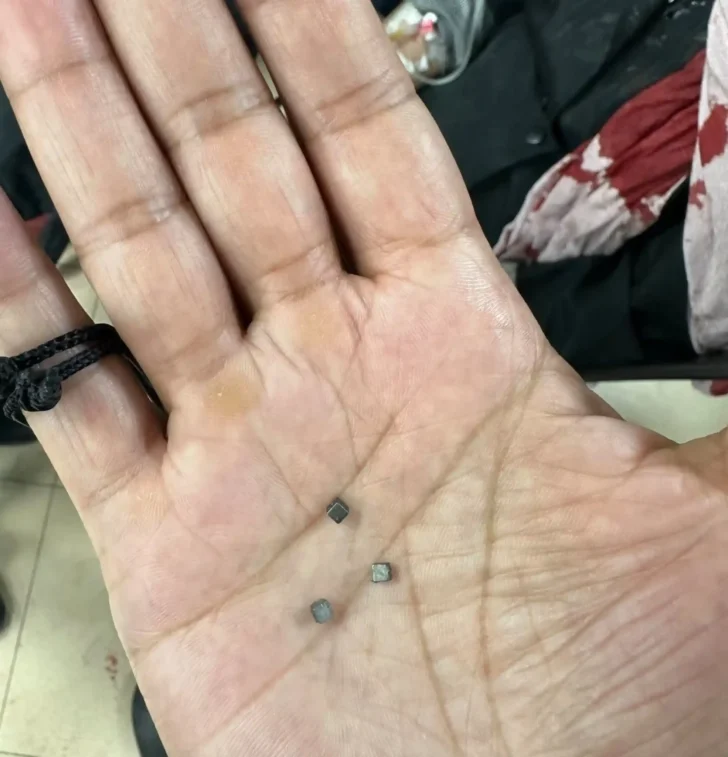
“They appear designed to cause maximum injury and, in some respects, seem to be a more sophisticated version of the ball-bearings or nails and bolts which armed groups often pack into crude rockets and suicide bombs,” Amnesty said in a report at the time.
Ball said that weapons fitted with fragmentation sleeves are “relatively small munitions” compared with the bombs that have a wide blast area and have damaged or destroyed more than half the buildings in Gaza. But because they are packed with additional metal, they are very deadly in the immediate vicinity. The shrapnel from a Spike missile typically kills and severely wounds over a 65-foot (20 meter) radius.
Another weapons expert, who declined to be named because he sometimes works for the US government, questioned the use of such weapons in areas of Gaza crowded with civilians.
“The claim is that these weapons are more precise and limit casualties to a smaller area. But when they are fired into areas with high concentrations of civilians living in the open with nowhere to shelter, the military knows that most of the casualties will be those civilians,” he said.
The M329 shell is one of several weapons used by the Israeli army with added fragmentation. The projectile is 29.5 inches (750mm) long and weighs 59.5 pounds (27kg).



In response to questions about the use of fragmentation weapons in areas with concentrations of civilians, the Israel Defense Forces said that military commanders are required “to consider the various means of warfare that are equally capable of achieving a defined military objective, and to choose the means that is expected to cause the least incidental damage under the circumstances.
“The IDF makes various efforts to reduce harm to civilians to the extent feasible in the operational circumstances ruling at the time of the strike,” it said.
“The IDF reviews targets before strikes and chooses the proper munition in accordance with operational and humanitarian considerations, taking into account an assessment of the relevant structural and geographical features of the target, the target’s environment, possible effects on nearby civilians, critical infrastructure in the vicinity, and more.”
The UN children’s agency, UNICEF has said that “staggering” numbers of children have been wounded in Israel’s assault on Gaza. The United Nations estimates that Israel has killed more than 38,000 people in Gaza in the present war of which at least 8,000 are confirmed to be children, although the actual figure is likely to be much higher. Tens of thousands have been wounded.
In June, the UN added Israel to a list of states committing violations against children during conflict, describing the scale of killing in Gaza as “an unprecedented scale and intensity of grave violations against children”, principally by Israeli forces.
Many of the cases recalled by the surgeons involved children severely injured when missiles landed in or near areas where hundreds of thousands of Palestinians are living in tents after being driven from their homes by the Israeli assault.
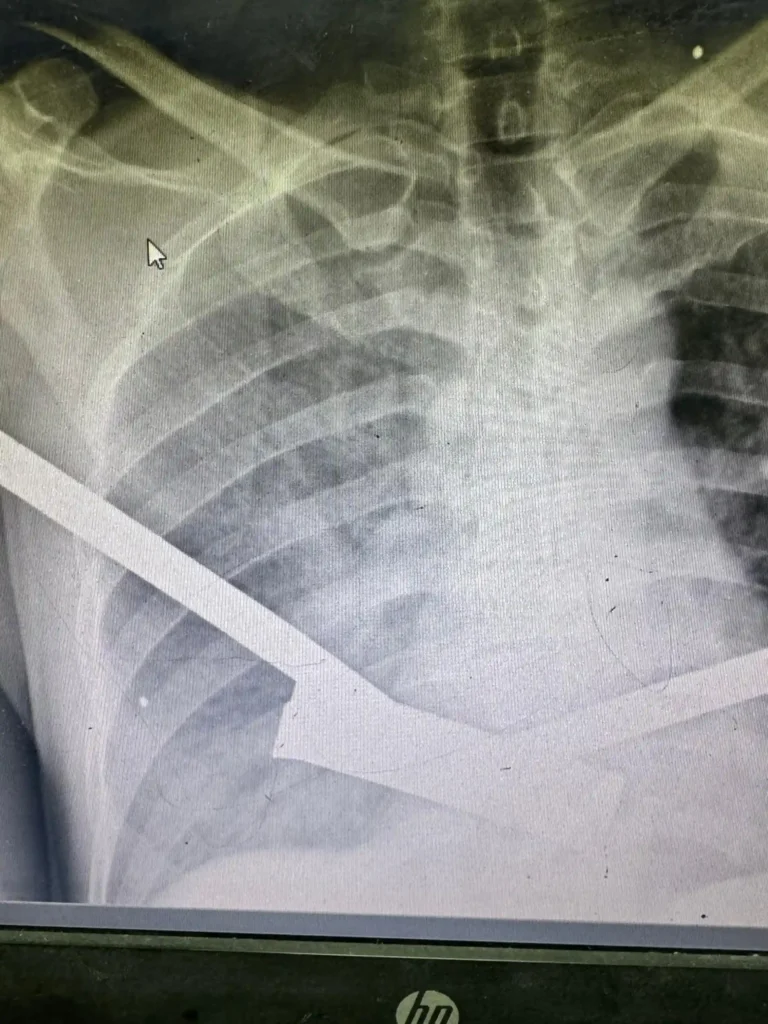
Perlmutter described repeatedly encountering similar wounds.
“Most of our patients were under 16,” he said. “The exit wound is only a couple millimeters big. The entrance wound is that big or smaller. But you can see it is extremely high velocity because of the damage it does on the inside. When you have multiple small fragments travelling at insane speeds, it does soft tissue damage that far outweighs the size of the fragment.”
Adusumilli described treating a six-year-old boy who arrived at the hospital after an Israeli missile strike close to the tent where his family was living after fleeing their home under Israeli bombardment. The surgeon said the child had pinhole wounds that gave no indication of the scale of the damage beneath the skin.
“I had to open his abdomen and chest. He had lacerations to his lung, to his heart, and holes throughout his intestine. We had to repair everything. He was lucky that there was a bed in the intensive care unit. But, despite that, that young boy died two days later,” he said.
An American emergency room doctor now working in central Gaza, who did not want to be named for fear of jeopardizing his work there, said that medics continue to treat deeply penetrating wounds created by fragmentation shards. The doctor said he had just worked on a child who suffered wounds to his heart and major blood vessels, and a build up of blood between his ribs and lungs that made it difficult to breathe.
Sidhwa said that “about half of the patients that we took care of were children”. He kept notes on several, including a nine year-old girl, Jouri, who was severely injured by shards of shrapnel in an air strike on Rafah.
“We found Jouri dying of sepsis in a corner. We took her to the operating room and found that both of her buttocks had been completely flayed open. The lowest bone in her pelvis was actually exposed to the skin. These wounds were covered in maggots. Her left leg she was missing a big chunk of the the muscles on the front and back of the leg, and then about two inches of her femur. The bone in the leg was just gone,” he said.
Sidhwa said doctors were able to save Jouri’s life and treat septic shock. But in order to save what remained of her leg, the surgeons shortened it during repeated operations.
The problem, said Sidhwa, is that Jouri will need constant care for years to come and she’s unlikely to find it in Gaza.
“She needs advanced surgical intervention every one to two years years as she grows to bring her left femur back to the length it needs to be to match her right leg, otherwise walking will be impossible,” he said.
“If she does not get out of Gaza, if she survives at all, she will be permanently and completely crippled.”
Adusumilli said fragmentation weapons resulted in high numbers of amputations among children who survived.
“It was unbelievable the number of amputations we had to do, especially on children, he said. “The option you’ve got to save their life is to amputate their leg or their hands or their arms. It was a constant flow of amputations every day.”
Adusumilli operated on a seven year-old girl who was hit by shrapnel from a missile that landed near her family’s tent.
“She came in with her left arm completely blown off. Her family brought the arm in wrapped in a towel and in a bag. She had shrapnel injuries to her abdomen so I had to open up her abdomen and control the bleeding. She ended up having her left arm amputated,” he said.
“She survived but the reason I remember her is because as I was rushing into the operating theater, she reminded me of my own daughter and it sort of it was very difficult to accept emotionally.”
UNICEF estimated that in the first 10 weeks of the conflict alone about 1,000 children lost one or both of their legs to amputations.
The doctors said that many of the limbs could be saved in more normal circumstances but that shortages of medicines and operating theaters limited surgeons to carrying out emergency procedures to save lives. Some children endured amputations without anesthetic or painkillers afterwards which hindered their recovery alongside the challenges of rampant infections because of unsanitary conditions and lack of antibiotics.
Adusumilli said that, as a result, some children saved on the operating table died later when they could have been saved in different conditions.
“The sad part is that you do what you can to try and help these kids. But at the end of the day, the fact that the hospital is so overcrowded and doesn’t have the resources in intensive care, they just end up dying later on.”
Chris McGreal writes for Guardian US and is a former Guardian correspondent in Washington, Johannesburg and Jerusalem. He is the author of “American Overdose, The Opioid Tragedy in Three Acts”
RELATED ARTICLES:
-
- Ilan Pappé on Israel’s Relentless War against Palestinian Children
- Israel’s epidemic rate of medical permit denial for Gaza’s children
- WATCH: Gaza’s Children: Innocence Lost
- Israel kills Palestinian kids, then kills funeral attendee, then ransacks Defense of Children office
- A Scarred Childhood: Israeli Attacks against Palestinian Children in the Occupied West Bank in 2022
- Palestinian children held in solitary confinement by Israel surges
- ‘Not a normal war’: doctors say children have been targeted by Israeli snipers in Gaza
- ‘I’m bored, so I shoot’: The Israeli army’s approval of free-for-all violence in Gaza
- Israeli prof: Israel tests weapons on Palestinian kids, tests drugs on prisoners
- Thanks to Gaza protests, Israel has a new crop of ‘battle tested’ weapons for sale

